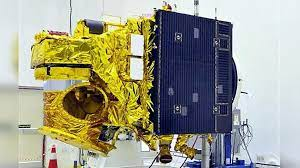Science & Technology
Megha-Tropiques-1 Satellite
- 09 Mar 2023
- 3 min read
Prelims: Megha-Tropiques-1 Satellite, ISRO, Re-entry of Satellite, CNES, Earth Observation Satellite.
Mains: Megha-Tropiques-1 Satellite.
Why in News?
Recently, the Indian Space Research Organisation (ISRO) has successfully carried out the controlled Re-Entry experiment for the decommissioned Megha-Tropiques-1 (MT-1) Satellite.
- An uninhabited area in the Pacific Ocean between 5°S to 14°S latitude and 119°W to 100°W longitude was identified as the targeted re-entry zone for MT1.
What is Controlled Re-entry?
- Controlled re-entries involve de-orbiting to very low altitudes to ensure the impact occurs within a targeted safe zone.
- Usually, large satellites or rocket bodies, which are likely to survive aero-thermal fragmentation upon re-entry, are made to undergo controlled re-entry to limit ground casualty risk.
- Aero-Thermal Fragmentation is a process in which an object traveling through the Earth's atmosphere at high-speed experiences extreme heat and pressure, causing it to break apart or fragment.
- However, all such satellites are specifically designed to undergo controlled re-entry at end-of-life.
What are the Key points of the MT-1 Satellite?
- About:
- It is an Indo-French Earth Observation Satellite, which was launched in October 2011 for carrying out tropical weather and climate studies
- The main objective of this mission is to understand the life cycle of convective systems that influence the tropical weather and climate and their role in the associated energy and moisture budget of the atmosphere in tropical regions.
- With its circular orbit inclined 20° to the equator, it is a unique satellite for climate research that aided scientists seeking to refine prediction models.
- Payloads:
- Microwave Analysis and Detection of Rain and Atmospheric Structures (MADRAS), an Imaging Radiometer developed jointly by CNES (Centre National d'études Spatiales), France and ISRO;
- Sounder for Probing Vertical Profiles of Humidity (SAPHIR), from CNES;
- Scanner for Radiation Budget (ScaRaB), from CNES;
- Radio Occultation Sensor for Vertical Profiling of Temperature and Humidity (ROSA), procured from Italy.







